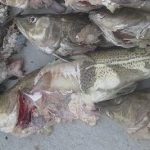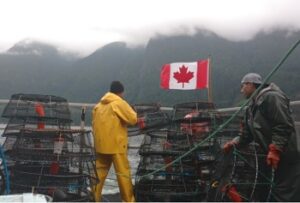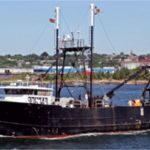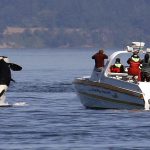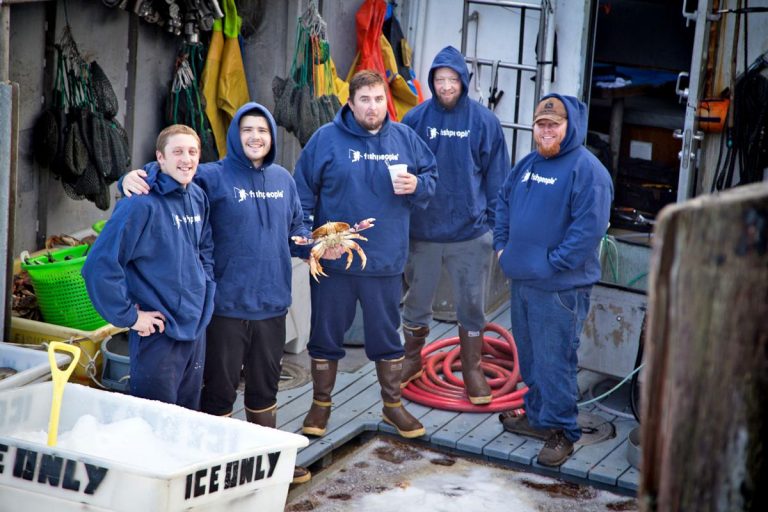Tag Archives: Endangered Species Act
If loggerheads are coming back, are more protections needed? How much does a species have to rebound before being taken off the endangered list?

When the federal government recently designated 68 miles of Cape Fear region coastline as critical habitat for loggerhead sea turtles, some local officials questioned the need for more – potentially costly – protections. So the proposed regulation, required under the Endangered Species Act, raises the question: How much does the species have to rebound before being taken off the endangered list? more@starnewsonline08:02:26
National Marine Fisheries Service : These Orca’s are Special! tu parli l’inglese?

The National Marine Fisheries Service spent a year reviewing a petition to delist the orcas from the Endangered Species Act. “We have decided these killer whales are a distinct population group,” Gorman said. “They have their own language, own food source. They don’t interbreed with other groups of killer whales. They meet the legal standard for a distinct population group.” continued@katu
(I dunno. They look the same, but I don’t speak the language!)
PLF challenges bureaucrats’ decision to ignore Congress, let sea otters decimate Southern California fisheries
 We represent four organizations that rely on the health of SoCal fisheries—the California Sea Urchin Commission, California Abalone Association, California Lobster and Trap Fishermen’s Association, and the Commercial Fishermen of Santa Barbara. The otter threatens the ability of these fisherman to put food on their table, literally. And the effects will ripple because of the many local businesses that are related to fishing. [email protected]
We represent four organizations that rely on the health of SoCal fisheries—the California Sea Urchin Commission, California Abalone Association, California Lobster and Trap Fishermen’s Association, and the Commercial Fishermen of Santa Barbara. The otter threatens the ability of these fisherman to put food on their table, literally. And the effects will ripple because of the many local businesses that are related to fishing. [email protected]
Shellfish Industry Lobs Bomb at Sea Otters @courthousenews
Lawsuit challenges sea otter boundary change @the heraldnews
Endangered Species Act gone wild! The ENGO Northern spotted owl in the Coal Mine?, or Nature Prevail’s despite Meddling
 Endangered Species Act gone wild! It’s too bad another species of owl must lose its life in the process: Authorities are proposing to shoot or remove more than 3,600 barred owls from four test areas of California, Oregon and Washington forests. The more successful barred owls — larger, less picky about their food and more aggressive — have taken over much of the spotted owl’s territory. That territory used to be prime timber harvest land until the Endangered Species Act, which protects the spotted owl, forced the government to shut down 90 percent of logging on federal lands in the Pacific Northwest. continued@dalleschronicle
Endangered Species Act gone wild! It’s too bad another species of owl must lose its life in the process: Authorities are proposing to shoot or remove more than 3,600 barred owls from four test areas of California, Oregon and Washington forests. The more successful barred owls — larger, less picky about their food and more aggressive — have taken over much of the spotted owl’s territory. That territory used to be prime timber harvest land until the Endangered Species Act, which protects the spotted owl, forced the government to shut down 90 percent of logging on federal lands in the Pacific Northwest. continued@dalleschronicle
Center for Biological Diversity “tree huggers,” Endangered Species Act bid has PROP partnership concerned it – 4,000 year history of taking care of its coral

The Pacific Islands Regional Ocean Partnership or PROP has great concerns over a proposed listing of 66 reef building corals under the Endangered Species Act (ESA). Calling the group “tree huggers,” Guam President Joseph Cameron Guam’ says PROP has a problem with that request because these people have never been to the pacific. continued@islandbusiness
WildEarth Guardians seeks doubling of marine species protected by Endangered Species Act
 Of the 1,475 U.S. species protected by the landmark 40-year-old law, only 94 live in the oceans. The conservation group WildEarth Guardians contends there is no scientific basis for that disparity. continued@washintonpost
Of the 1,475 U.S. species protected by the landmark 40-year-old law, only 94 live in the oceans. The conservation group WildEarth Guardians contends there is no scientific basis for that disparity. continued@washintonpost
National Marine Fisheries Service proposed five species of sawfish for endangered listing status under the Endangered Species Act
WASHINGTON (CN) – The National Oceanic and Atmospheric Administration’s National Marine Fisheries Service has proposed five species of sawfish for endangered listing status under the Endangered Species Act, according to a new regulation. The action is in response to a 2010 petition from WildEarth Guardians (WEG), the environmental group’s press release stated. continued @ courthouse news
Seven major Commercial Fisheries cleared by NOAA of harming or posing a threat to the iconic sturgeon
 fishnewsseu.com – A DRAFT Biological Opinion released by US National Oceanic and Atmospheric Administration (NOAA) today, found that seven existing commercial fisheries in New Jersey pose “no jeopardy” for Atlantic sturgeon. This determination, formalised by a Section 7 Consultation required under the federal Endangered Species Act (ESA), applies to the northeast multispecies, monkfish, spiny dogfish, Atlantic bluefish, northeast skate, squid/mackerel/butterfish, and summer flounder/scup/black sea bass fisheries. continued
fishnewsseu.com – A DRAFT Biological Opinion released by US National Oceanic and Atmospheric Administration (NOAA) today, found that seven existing commercial fisheries in New Jersey pose “no jeopardy” for Atlantic sturgeon. This determination, formalised by a Section 7 Consultation required under the federal Endangered Species Act (ESA), applies to the northeast multispecies, monkfish, spiny dogfish, Atlantic bluefish, northeast skate, squid/mackerel/butterfish, and summer flounder/scup/black sea bass fisheries. continued
NOAA’s Fisheries Service Seeks Comments on Proposal to List Scalloped Hammerhead Sharks under Endangered Species Act
WASHINGTON, April 4 — The U.S. Department of Commerce’s National Oceanic and Atmospheric Administration issued the following news release: NOAA’s Fisheries Service, in response to a petition submitted by the WildEarth Guardians and Friends of Animals is proposing to list four populations of scalloped hammerhead sharks under the Endangered Species Act, two as threatened and two as endangered. continued
Officials: Elver eel season stunted by low temperatures, prices – Fishery in the government crosshairs!
 ELLSWORTH, Maine — The 2013 elver fishing season in Maine has begun with cooler temperatures and cooler prices, according to a state official. “They’re a little bit on the spotty side,” Separate from the Atlantic States Marine Fisheries Commission process, the U.S. Fish & Wildlife Service is considering listing American eels under the federal Endangered Species Act, which could result in a ban on all American eel fishing. continue reading
ELLSWORTH, Maine — The 2013 elver fishing season in Maine has begun with cooler temperatures and cooler prices, according to a state official. “They’re a little bit on the spotty side,” Separate from the Atlantic States Marine Fisheries Commission process, the U.S. Fish & Wildlife Service is considering listing American eels under the federal Endangered Species Act, which could result in a ban on all American eel fishing. continue reading
A desperate try to restock the Potomac’s sturgeon
 Believe it or not, there’s a Chesapeake Bay fish in even worse shape than the recovering striped bass, the troubled blue crab and even the imperiled bay oyster. The Atlantic sturgeon, pushed to the brink of extinction by overfishing and development, is little more than a memory in the Potomac River, ready for a spot in a museum. Read more, and treat yourself to the Wapo comments.
Believe it or not, there’s a Chesapeake Bay fish in even worse shape than the recovering striped bass, the troubled blue crab and even the imperiled bay oyster. The Atlantic sturgeon, pushed to the brink of extinction by overfishing and development, is little more than a memory in the Potomac River, ready for a spot in a museum. Read more, and treat yourself to the Wapo comments.
Reminder — Gillnet Bycatch Workshop in Ocean City, Maryland — on January 22 and 23 — You can join via webinar!
Jan 22, 2013 12:30 PM – 6:00 PM EST
Jan 23, 2013 10:30 AM – 1:00 PM EST
Register Now at: https://www3.gotomeeting.com/
Center for Biological Diversity, Oceana Inc and Turtle Island Restoration Sue the NMFS/F+WS (us) AGAIN! Loggerhead’s at the brink of extinctio………
The lawsuit said loggerheads were already being pushed to the brink of extinction and that the government had failed to comply with deadlines set under the Endangered Species Act to establish protected areas or “critical habitat” for loggerhead sea turtle populations. The suit, brought by the Center for Biological Diversity, Oceana Inc and Turtle Island Restoration, cited the destruction or degradation of nesting and foraging habitats, pollution including oil spills, climate change and sea level rise among other threats to the long-term survival of the marine turtles. Of course, “incidental capture, injury and death by commercial fishing fleets”. Read More
Federal government lists 2 ice seals as threatened. (here we go)
ANCHORAGE, Alaska — Two types of ice seals joined polar bears Friday on the list of species threatened by the loss of sea ice, which scientists say reached record low levels this year due to climate warming. Ringed seals, the main prey of polar bears, and bearded seals in the Arctic Ocean will be listed as threatened under the Endangered Species Act, the National Oceanic and Atmospheric Administration announced. A species is threatened if it’s likely to become endangered within the foreseeable future throughout a significant portion of its range.( A hundred years forseeable?) Read More

A Rising Tide of Noise Is Now Easy to See – new york times
“What quiet, what silence, what peace!” Captain Nemo That was 1870. Today — to the dismay of whale lovers and friends of marine mammals, if not divers and submarine captains — the ocean depths have become a noisy place. The causes are human: the sonar blasts of military exercises, the booms from air guns used in oil and gas exploration, and the whine from fleets of commercial ships that relentlessly crisscross the global seas. Nature has its own undersea noises. But the new ones are loud and ubiquitous. http://www.nytimes.com/2012/12/11/science/project-seeks-to-map-and-reduce-ocean-noise-pollution.html?ref=science
Salmon won’t be getting help from Delta gates, This year the gates will not be closed.
Water diversion gates in the Sacramento-San Joaquin Delta near Walnut Grovewill not be closed this month to assist migrating salmon, as they were last year. The Delta Cross Channel Gates, operated by the U.S. Bureau of Reclamation, were built in 1953. They are typically open in fall to divert fresh water from the Sacramento River to the interior of the Sacramento-San Joaquin Delta. This reduces the salinity of water exported from the Delta for urban and farm use. In recent years, concern has emerged that salmon migrating upstream to spawn in the Mokelumne River are disoriented by flows diverted through the gates and often end up spawning in the wrong stream. So the gates were closed last year for 10 days in October, which may have contributed to a rebound in salmon production at the Mokelumne River Hatchery, operated by the state Department of Fish and Game.
http://www.sacbee.com/2012/10/23/4930924/salmon-wont-be-getting-help-from.html
Eco-Lawsuit Advances against Cape Wind Risk to Right Whale and other Threatened and Endangered Species Litigated
NOTE. Links will be added as they become available. http://www.milforddailynews.com/news/x493268917/Suit-claims-Cape-Wind-violates-endangered-species-law
Hyannis, Mass. (October 10, 2012) – Public Employees for Environmental Responsibility (PEER), the Alliance to Protect Nantucket Sound and other conservation groups today filed a brief in U.S. District Court for the District of Columbia detailing Cape Wind’s numerous violations of federal protections for threatened and endangered species – including the imperiled North Atlantic right whale, one of the rarest mammals in the world. This suit charges the project violates three key federal laws – the Endangered Species Act, the Migratory Bird Treaty Act and the National Environmental Policy Act.
Other plaintiffs include the Cetacean Society International, Lower Laguna Madre Foundation, Californians for Renewable Energy, and Three Bays Preservation. This is one of five federal lawsuits facing Cape Wind, a massive industrial project proposed to cover 25 square miles of Nantucket Sound with an array of 130 massive turbines – each stretching taller than the Statue of Liberty.
Today’s brief explains how the mega-project poses serious risks to the right whale, four species of federally-protected sea turtles and several species of migratory birds. It also criticizes the lack of oversight and analysis of the impact of Cape Wind on this critical habitat.
Bay Area enviros target use of drift gill nets – litigation threat from Oceana, Center for Biological Diversity, Turtle Island Restoration Network
SANTA CRUZ – Calling them “curtains of death,” Bay Area environmentalists have put the federal government on notice that they intend to sue to halt the controversial use of drift gill nets for commercial fishing. Sometimes more than a mile long, the nets are used in the waters off California to catch shark and swordfish. But because they can sweep up unintended catch – including rare and endangered species such as sperm whales and leatherback sea turtles – environmentalists have long criticized their use. “Ultimately, what we’re trying to do is eliminate drift gill nets from being used off the California coast altogether,” said Dr. Geoff Shester, California program director for Monterey-based Oceana. “These are the lions and tigers of our blue Serengeti, but here we are allowing this fishery to continue.” The litigation threat comes from Oceana and the San Francisco-based Center for Biological Diversity and Turtle Island Restoration Network – groups that have pushed aggressively for everything from fishery changes to marine habitat protections to designation of the endangered leatherbacks as California’s official marine reptile. In operation since 1980, the drift gill net fishery has long been under fire from environmentalists. While allowed under federal law, both Oregon and Washington have banned them along their coasts. The National Oceanic and Atmospheric Administration said it was too early to comment on the potential suit, which would be filed under the Endangered Species Act. “We’re still evaluating it,” NOAA spokesman Jim Milburn said. In announcing the suit, environmentalists said they are concerned that two endangered sperm whales were caught by a drift gill net in December 2010. Based on,,,,,,,,Read More http://www.mercurynews.com/california/ci_21483913/bay-area-enviros-target-use-drift-gill-nets

































